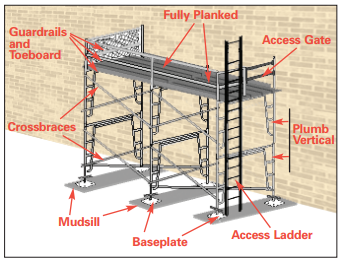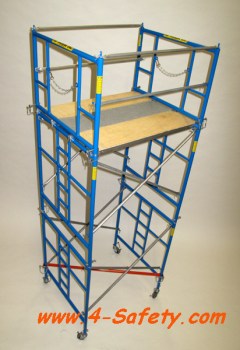Local Scaffolding Company Providing Reliable Services Throughout Surrey
Local Scaffolding Company Providing Reliable Services Throughout Surrey
Blog Article
Discovering the Various Kinds of Scaffolding Made Use Of in Building And Construction Tasks
The building and construction market counts greatly on different kinds of scaffolding to satisfy specific project requirements, each offering distinctive advantages and applications. Traditional structure scaffolding supplies a tough foundation for general tasks, while suspended scaffolding is important for job on skyscraper frameworks.

Traditional Structure Scaffolding
Typical framework scaffolding is among the most widely used techniques in the building industry because of its toughness and flexibility. This system contains vertical and straight structures that are set up to develop a steady platform for workers and materials. The main components include upright articles, straight journals, and angled braces, which together give a solid structure that can support significant lots.
Among the crucial benefits of traditional structure scaffolding is its versatility to numerous building and construction jobs, varying from domestic structures to large industrial structures. The modular style permits very easy assembly and disassembly, making it efficient for both temporary and long-lasting jobs. Additionally, the system can be tailored in height and size, suiting different building styles and website problems.
Security is paramount in scaffolding applications, and standard structure systems are geared up with guardrails and toe boards to avoid drops and ensure worker security. Routine inspections and adherence to security guidelines are crucial in keeping the integrity of the scaffold (Scaffolding). In general, standard structure scaffolding stays a fundamental option in the building and construction sector, giving a trustworthy system for labor and boosting total job efficiency

Suspended Scaffolding
Suspended scaffolding provides a special option for construction projects that call for access to elevated surface areas, particularly in scenarios where typical structure scaffolding may be impractical. This kind of scaffolding is typically put on hold from the roofing or upper degrees of a framework, using a system of platforms, wheels, and ropes to produce a working room that can be adapted to various heights.
One of the main advantages of put on hold scaffolding is its flexibility. It can be conveniently rearranged or lowered to fit changes in construction requirements, making it excellent for tasks such as window installment, frontage job, and maintenance on high-rise buildings. Furthermore, the minimal impact of put on hold scaffolding enables far better use ground room in urban atmospheres, where area is often restricted.
Safety is a crucial factor to consider in making use of suspended scaffolding. Proper rigging and anchoring systems need to be employed to guarantee stability and protect against accidents. Operators needs to additionally be educated in the safe use of this devices. On the whole, suspended scaffolding gives a efficient and efficient option for accessing hard-to-reach locations in numerous construction circumstances, enhancing both efficiency and security on website.
System Scaffolding
System scaffolding, frequently considered as a contemporary service in the scaffolding sector, contains pre-engineered components that can be quickly assembled and adjusted for different building and construction projects. Scaffolding. This kind of scaffolding is defined by its modular style, which permits flexibility and efficiency on work websites, fitting different heights and architectural demands
Usually made from high-strength steel or aluminum, system scaffolding offers enhanced longevity and security. The components consist of upright blog posts, straight ledgers, and angled dental braces, which interconnect securely, making certain a durable framework. The design commonly integrates standardized installations, simplifying setting up and disassembly procedures, thereby reducing labor time and expenses.

Rolling Scaffolding
Moving scaffolding is a versatile alternative to conventional fixed scaffolding, designed for wheelchair and simplicity of use on building websites. This kind of scaffolding includes a system sustained by structures with wheels, permitting workers to easily transfer it as required. The wheelchair attribute dramatically boosts performance, as it reduces downtime connected with setting up and taking apart repaired scaffolding.
Usually built from lightweight products such as light weight aluminum or steel, rolling scaffolding uses a strong yet portable remedy for projects requiring frequent repositioning - Scaffolding. It is specifically beneficial in tasks such as paint, drywall setup, and electrical job, where access to various heights and areas is required
Safety is extremely important in rolling scaffolding style, with attributes such as securing wheels to stop unintended activity when in use, and guardrails to protect employees from falls. Additionally, several designs are flexible in height, fitting numerous job demands.
Cantilever Scaffolding

The style of cantilever scaffolding normally includes utilizing brackets or arms anchored to a building or structure, enabling the system to extend external safely. Safety is paramount; hence, these scaffolds must be crafted to withstand environmental problems and numerous loads. Routine assessment and upkeep are necessary to ensure structural honesty and employee safety.
Cantilever scaffolding is preferred Read Full Report for its convenience and reliable use space, making it a preferred selection in city settings where space Get the facts restraints are typical. It promotes less complicated accessibility to high elevations, inevitably contributing to the general efficiency of building and construction projects. Similar to all scaffolding types, appropriate training and adherence to safety and security requirements are essential for workers making use of cantilever scaffolding.
Verdict
Conventional structure scaffolding supplies security, while put on hold scaffolding uses convenience for raised tasks. System scaffolding helps with quick assembly, and rolling scaffolding enhances movement for varying work atmospheres.
Standard framework scaffolding offers a strong structure for general tasks, while put on hold scaffolding is important for job on skyscraper frameworks.Rolling scaffolding is a versatile alternative to typical set scaffolding, created for movement and simplicity of use on building sites. As with all scaffolding types, correct training and adherence to safety and security criteria are essential for employees utilizing cantilever scaffolding.
Conventional frame scaffolding provides Read Full Article security, while suspended scaffolding uses adaptability for elevated tasks. System scaffolding promotes fast setting up, and rolling scaffolding improves movement for differing job settings.
Report this page